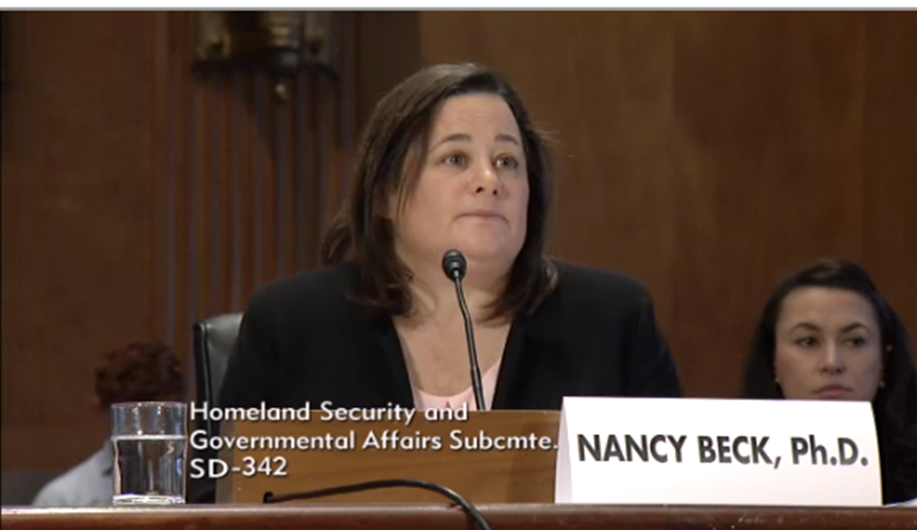President Trump has nominated Dr. Nancy Beck for the role of chair and commissioner of the Consumer Product Safety Commission, an agency charged with “protecting the public from unreasonable risks of injury or death” related to the use of consumer products on the market. The American Chemistry Council representative turned EPA chemicals-focused political appointee, Beck has made headlines for egregious changes to EPA process and policy that have resulted in measures that fail to adequately protect all of us, particularly children.
For example, her fingerprints were all over a recently released risk assessment for the chemical, Trichloroethylene (TCE), a degreasing solvent used in dry-cleaning and industrial manufacturing, which ignores EPA scientists and the body of evidence linking TCE exposure at low levels to fetal heart deformation. This is just the most recent in a very long list of ways in which Nancy Beck has altered EPA’s work to sow doubt around established science and allowed industry to continue conducting practices that put us in harm’s way. While she may have scientific credentials, her work history is chock full of reasons she should not be chosen to lead agencies responsible for protecting public health.
Beck’s tactics are in line with industry’s disinformation playbook
At UCS, we have encountered and tracked how industries, ranging from chemicals to food, have used a range of tactics—termed the Disinformation Playbook—to sow doubt about established science or change scientific processes in order to make it easier for industry-sponsored research to be considered over independent research to support regulatory decisions. Beck, coming from one of the most enthusiastic users of that playbook, the American Chemistry Council (ACC), has been using those same tactics throughout her career—from within the Office of Management and Budget (OMB) from 2002 to 2012, ACC from 2012 to 2017, the EPA, and during a detail at the White House. Some of her go-to strategies to undermine science have been:
Playing up uncertainty of health-adverse findings
- At OMB, Beck frequently made direct edits to scientific conclusions to increase a sense of uncertainty (e.g., PBDEs, Dibutyl Phthalate) and directly edited out scientists’ mention of potential human health implications in a number of research papers.
Playing down existing research, especially animal studies
- At OMB, Beck criticized reliance on animal studies; edited out discussions of potential implications for human health (e.g., PBDEs, Dibutyl Phthalate); increased vagueness of findings in research papers about adverse health effects; at the EPA, she downplayed the real-world impacts of toxic chemicals.
Criticizing health-protective dose response models
- At ACC, Beck criticized lack of research on low-dose exposures (e.g., on inorganic arsenic), a direct challenge to the precautionary linear no-threshold model.
Trying to limit the sources of risks that would be considered for chemical assessments
- At ACC, Beck lobbied EPA to limit “refined” (more rigorous) risk evaluation to only certain chemicals; suggested that “EPA need not include every conceivable condition of use in a risk evaluation”; and accomplished this in changes to TSCA once she joined EPA.
Encouraging consideration of industry-funded research despite conflicts
- At ACC, Beck argued to EPA that all research, “regardless of affiliation or funding source,” should be considered for cancer assessments (e.g., inorganic arsenic).
Calling for “underlying data” in research
- At ACC, Beck criticized EPA chemical assessments for not divulging the value or limitations of underlying research studies (e.g., 1-bromopropane) and was one of the architects behind EPA’s restricted science rule.
Co-opting terms like “best available science”
- At ACC (and only a few months later at EPA), Beck criticized the EPA for its definitions of “best available science” and “weight of the scientific evidence” and called for updates to the terms during Senate testimony in 2017.
Slowing down the chemical review process
- At OMB, Beck and other officials pressed IRIS to revamp its review process, incorporating more OIRA review which would delay release; these efforts led to a House committee to conduct a full investigation and publish a scathing report on those efforts in 2009.
We need CPSC to protect us, not industry’s image or profits
Nancy Beck is now in the position to bring her playbook and the damage that comes with its deployment to the CPSC. As the chair, Beck will be one of three Trump administration appointees to the five-person Commission, and has the power to set priorities for the agency.
Last month, we issued a report about how the Trump administration’s assault on science is harming children’s health. Not only were Nancy Beck’s fingerprints on several case studies, most notably EPA’s failure to ban chlorpyrifos, examine legacy uses of asbestos, or take adequate action to regulate PFAS, but we documented how the CPSC’s enforcement broadly and also of children’s products has decreased under the Trump administration.

In 2017, under the Trump administration, recalls of children’s products dropped to their lowest level in more than a decade. Replacing recalls
of products with educational campaigns or no actions at all lets companies off the hook and puts children at risk. Source: CPSC
In 2018, the acting CPSC chair, Ann Marie Buerkle, actively sided with a manufacturer of a defective jogging stroller in making decisions about a recall that parents and caregivers across the country should have been notified about in order to keep themselves and their kids safe from injury.
With enforcement down at CPSC, the agency needs a chair who will help meet its mission rather than side with industry on more decisions that will surely mean less interest in independent science and more protection for industry from enforcement actions that will harm their reputations or profit margins.
Just as Beck’s definition of “best available science” doesn’t meet ours, her definition of “unreasonable risk” or of a “safe product” cannot be trusted. Beck’s track record has proven that she is not looking out for the health of our children and is catering entirely to industry’s wishes to keep chemicals in use and products on the market. As a result, she is the antithesis of the right person to chair the Consumer Product Safety Commission, and her nomination should be withdrawn.
Special thanks to Taryn MacKinney for her research contributions to this blog.

